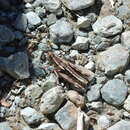pms
nòm ant ël fil


Sigaus australis is the most common alpine grasshopper found in New Zealand.[3][4] It can be found in the southern half of the South Island above the tree line. Sigaus australis was described in 1897 by Frederick Hutton. Like all of New Zealand sub-alpine and alpine grasshoppers S. australis has a 2 or 3 years life cycle. Individuals can survive the cold by freezing solid at any life stage, at any time of the year.[5] Sigaus australis adults are relatively large grasshoppers (females ~ 26mm, 0.8g).[6] The genus Sigaus is endemic to New Zealand.
Sigaus australis can be found in the southern half of the South Island, from Otago and Canterbury regions. It can be found as far south as the Takitimu Mountains[7] and as far north as the Torless Range (). Sigaus australis prefer tussock grasslands between 1,300–1,700 metres (4,300–5,600 ft) elevation, however, can be found as low as 200 metres (660 ft) on the Alexandra Tailings, ()[8] and as high as 2,000 metres (6,600 ft) on Smite Peak (). Evidence from mtDNA sequencing suggests that S. australis encompasses several narrow endemic taxa and one widespread species.[8]Sigaus australis would have been more widespread during the last glacial period with both morphological and genetic signature of greater population connectivity in the past.[7] With climate warming and low dispersal potential, S. australis will probably lose 75% to 93% of its suitable habitat by 2070.[9]
The wings on S. australis are micropterous (small wings) between 2–4 millimetres (0.079–0.157 in) making this species flightless like most of New Zealand grasshoppers. Sigaus australis is highly cryptic, with colour polymorphism.[7] They will match the surrounding vegetation with colours of green and earth tones.
Paprides australis Hutton (1897:147)
Paprides torquatus Hutton (1898:47)
Paprides armillaus Hutton (1898:47-48)
Sigaus australis is the most common alpine grasshopper found in New Zealand. It can be found in the southern half of the South Island above the tree line. Sigaus australis was described in 1897 by Frederick Hutton. Like all of New Zealand sub-alpine and alpine grasshoppers S. australis has a 2 or 3 years life cycle. Individuals can survive the cold by freezing solid at any life stage, at any time of the year. Sigaus australis adults are relatively large grasshoppers (females ~ 26mm, 0.8g). The genus Sigaus is endemic to New Zealand.
Sigaus australis is een rechtvleugelig insect uit de familie veldsprinkhanen (Acrididae). De wetenschappelijke naam van deze soort is voor het eerst geldig gepubliceerd in 1898 door Hutton.
Bronnen, noten en/of referenties